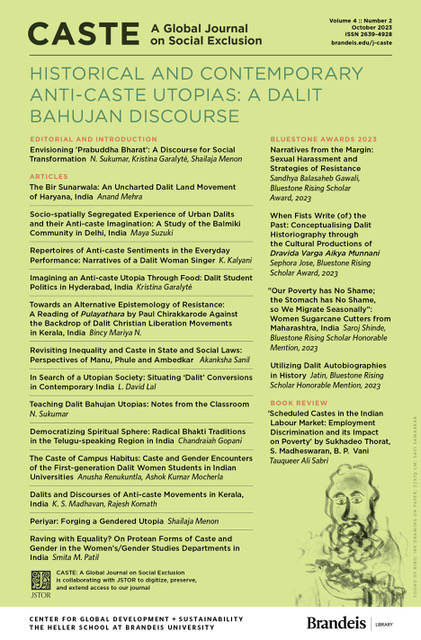Periyar: Forging a Gendered Utopia
Main Article Content
Abstract
The category of gender has perennially found itself at the margins because of its social location across South Asia. Albeit heterogeneous by nature, women have borne the burden of history, community, tradition and even geography being violently mapped across their bodies. No wonder that the past two centuries has witnessed heated debates on the women’s question in the region ranging from the Altekarian paradigm to the valorized mother figure who is ever nurturing and generous. Many social reformers both male and female sought to battle orthodoxy, religious chauvinism and caste-based status-quoism widening the contours of gender justice in the process. The tropes revolved around consent and coercion, public battles over scriptural legitimacy and contentious traditions. The reformers were treading on delicate grounds as the sacred domain of the ‘home’ had to be kept immune from any polluting winds of ‘western’ ideology. This article is an attempt to tease out E.V. Ramasamy Naicker’s (Periyar) radical understanding of the gender question and his efforts to create an alternate epistemology to question existing socio-cultural realities. It concludes by arguing that this gendered utopia is also a work in progress.
Downloads
Article Details

This work is licensed under a Creative Commons Attribution 4.0 International License.
A. CORRESPONDING AUTHOR’S GRANT OF RIGHTS
The Corresponding Author grants to the Journal, during the full term of copyright and any extensions or renewals of that term, the following:
- An irrevocable non-exclusive right to reproduce, republish, transmit, sell, distribute, and otherwise use the Work in electronic and print editions of the Journal and in derivative works throughout the world, in all languages, and in all media now known or later developed.
- An irrevocable non-exclusive right to create and store electronic archival copies of the Work, including the right to deposit the Work in open access digital repositories.
- An irrevocable non-exclusive right to license others to reproduce, republish, transmit, and distribute the Work under the condition that the Authors are attributed. (Currently this is carried out by publishing the content under a Creative Commons Attribution 4.0 license.)
Copyright in the Work remains with the Authors.
B. CORRESPONDING AUTHOR’S DUTIES
- When distributing or re-publishing the Work, the Corresponding Author agrees to credit the Journal as the place of first publication.
- The Corresponding Author agrees to inform the Journal of any changes in contact information.
C. CORRESPONDING AUTHOR’S WARRANTY
The Corresponding Author represents and warrants that the Work is the Authors’ original work and that it does not violate or infringe the law or the rights of any third party and, specifically, that the Work contains no matter that is defamatory or that infringes any literary or proprietary rights, intellectual property rights, or any rights of privacy. The Corresponding Author also warrants that he or she has the full power to make this agreement, and if the Work was prepared jointly, the Corresponding Author agrees to inform the Authors of the terms of this Agreement and to obtain their written permission to sign on their behalf. The Corresponding Author agrees to hold the Journal harmless from any breach of the aforestated representations.
D. JOURNAL’S DUTIES
In consideration of the Author’s grant of rights, the Journal agrees to publish the Work, attributing the Work to the Authors.
E. ENTIRE AGREEMENT
This agreement reflects the entire understanding of the parties. This agreement may be amended only in writing by an addendum signed by the parties. Amendments are incorporated by reference to this agreement.
